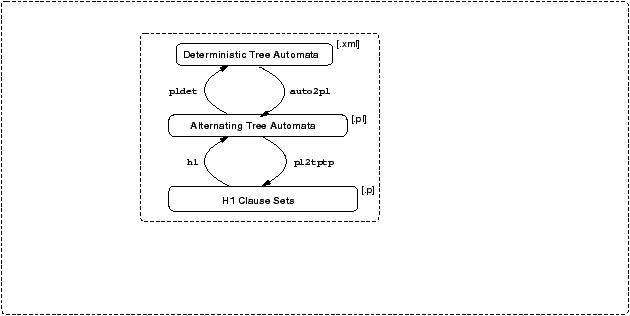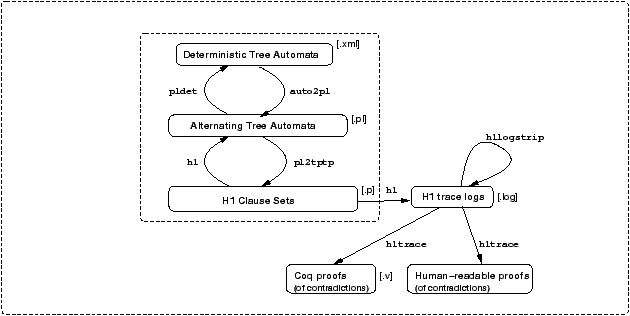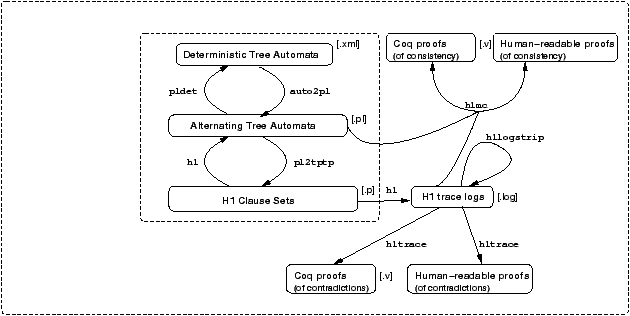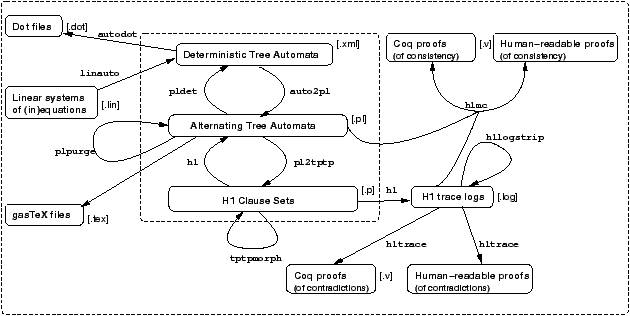

1 Introduction
The h1 tool suite is a toolchest for handling finite tree
automata, in various forms. There are basically three forms, from
most constrained to least constrained:
-
as deterministic bottom-up tree automata;
- as alternating tree automata;
- as pure Prolog programs (sets of Horn clauses) in the H1
class [2002 (Nielson et al.)].
The global architecture is given in the following figure. Some things are
still missing from it, and we will add them progressively later. The inner
dashed box forms the core of the h1 tool suite. The outer
dashed box is the h1 tool suite itself.
The main thing to understand is that the h1 tool suite includes tools to
convert between all three formats of tree automata, forming the core of the
h1 tool suite. The tools h1, pldet, auto2pl, pl2tptp are used to navigate between all three formats.
In the h1 tool suite, deterministic tree automata are
represented in files in XML format.
Alternating tree automata are represented as Horn clauses, in
Prolog notation; in particular, you can run them in any Prolog implementation
(whatever the use of this may be).
Finally, H1 clause sets are represented in TPTP format.
TPTP (a Thousand Problems for Theorem Provers) is a publicly available
repository used to test automated theorem provers, due to [2002 (Suttner and Sutcliffe)]. The
h1 tool suite handles TPTP input files that contain only clauses. This
allows you to use any automated, clausal theorem prover in place of the h1 prover if you so wish. The h1 prover, one of the tools of the
h1 tool suite, is an automated theorem prover. In addition to searching
for proofs, it is also able to produce counter-models and describe them as
alternating tree automata; h1 is described in Section 4.
Additional tools operate on such counter-models and proofs. They form
the rest of the h1 tool suite. As far as proofs are concerned,
the h1 tool keeps a trace of all proof steps it did in a trace log. This trace log is in a proprietary format that the
h1trace and h1logstring tools can work on. (Don't assume
anything on this format, it may change in the future.) This is
pictured in the following figure.
The purpose of h1trace is to explain the proofs found by h1, both to humans, as a proof in natural deduction in text format,
and to machines, as a formal proof, in Coq notation. Coq is a proof
assistant developed in the LogiCal team at INRIA Futurs [1999–2003 (Barras et al.)].
The h1 tool is also able to work on general clause sets, not just in the
H1 format. In this case, h1 will output a proof candidate,
which however may fail to be a proof. In case this is a wrong proof, h1trace will do its best to explain the wrong proof to humans. This can be
used to design a true proof.
In case a prover does not find a proof of some given query, you usually have
no choice but to trust it that there is indeed no proof. In case h1 does
not find a proof of some given query, it outputs a model. This model can be
independently checked by the h1mc model-checking tool; h1mc takes
as input both a description of the model M, as an alternating tree
automaton, and a trace log obtained from some given clause set S, and checks
whether the clauses in S all hold in the model M. This is a way
of getting confident that there is indeed no proof of the initial query, i.e.,
that your query is wrong. More useful is the fact that h1mc can give
you an explanation, based on M, why you query is wrong. As with
h1trace, this explanation can be made for humans, in text format, or in
Coq format, to be checked independently by the Coq proof assistant. This is
important in security protocols for instance, where a proof of secrecy
consists in showing that there is no proof of the fact that the intruder can
get hold of a given secret. This was shown by [2001 (Selinger)], see
[2004 (Goubault-Larrecq)]. Adding h1mc gives you the following picture of the
h1 tool suite.
The h1mc tool is described in Section 6.
Additionally, various tools are provided. First, there are two
conversion utilities, auto2pl, which converts deterministic tree
automata in XML format into Prolog format (Section 8);
and pl2tptp, which converts alternating tree automata in Prolog
format into TPTP format (Section 10). Since every
deterministic tree automaton is a particular case of an alternating
tree automaton, and every alternating tree automaton is a particular
case of an H1 clause set (see Section 2),
these two utilities entail no loss of information. In particular, to
convert deterministic tree automata into H1 clause sets,
just run auto2pl on the former, getting an intermediate file
which you then convert to H1 clause sets using pl2tptp.
Then, there are miscellaneous utilities. The first, plpurge,
extracts the part of a tree automaton that is relevant to certain
final states. In other words, it reads a tree automaton in Prolog
format, and eliminates all states and transitions that do not reach
any final state. This cleaning step is useful to help understand the
structure of automata computed by h1, in particular as a
preparation to calling pl2gastex. The plpurge tool is
described in Section 9. The second, tptpmorph,
applies certain kinds of morphisms to languages represented as
H1 clause sets. This is described in
Section 11. The need for it should become apparent
in conjunction with linauto, which implements
[1996 (Boudet and Comon)]'s algorithm for deciding
quantifier-free Presburger formulae by converting them to automata.
While linauto only deals with quantifier-free formulae,
existential quantification can be dealt with by using tptpmorph,
and universal quantification can be implemented using existential
quantification and complementation. Complementation can be
implemented by determinization (using pldet) and using auto2pl with the -negate option. The linauto tool is
described in Section 12.
Finally, pl2gastex is a utility that converts alternating tree
automata to a sequence of gasTEX macros, which can then be used in
conjunction with LATEX to display them on screen or include them in
documents. A former attempt of a tree automaton visualizer is
provided with autodot. The latter converts deterministic tree
automata to files in dot format; dot can then be applied
to these files to display them graphically. This is only useful for
relatively small automata, and is far from perfect for tree automata
that are not just word automata. Don't expect too much from pl2gastex and autodot on anything else but small automata.
The autodot utility is obsolescent: basically, it never gives
satisfying output. The pl2gastex utility is more satisfactory,
but not perfect. See Section 13.
At this point the picture of the h1 tool suite is complete—up to the
fact that I did not talk about some minor extensions yet, and that more
extensions may be added in the future.










